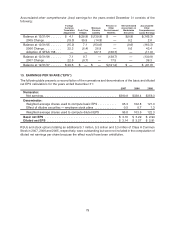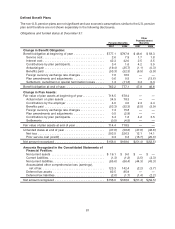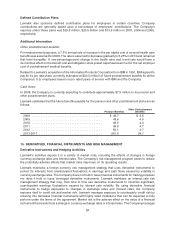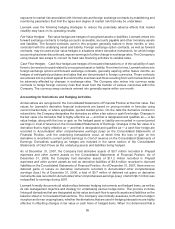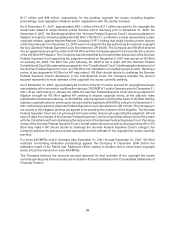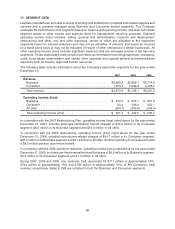Lexmark 2007 Annual Report Download - page 94
Download and view the complete annual report
Please find page 94 of the 2007 Lexmark annual report below. You can navigate through the pages in the report by either clicking on the pages listed below, or by using the keyword search tool below to find specific information within the annual report.in violation of the Sherman Act, the Lanham Act and state laws. SCC has stated in its legal documents that
it is seeking approximately $17.8 million to $19.5 million in damages for the Company’s alleged
anticompetitive conduct and approximately $1 billion for Lexmark’s alleged violation of the Lanham
Act. Clarity has not stated a damage dollar amount. SCC and Clarity are seeking treble damages,
attorney fees, costs and injunctive relief. On September 28, 2006, the District Court dismissed the
counterclaims filed by SCC alleging that the Company engaged in anti-competitive and monopolistic
conduct and unfair and deceptive trade practices in violation of the Sherman Act, the Lanham Act and state
laws. On October 13, 2006, SCC filed a Motion for Reconsideration of the District Court’s Order dismissing
SCC’s claims, or in the alternative, to amend its pleadings, which the District Court denied on June 1, 2007.
On October 13, 2006, the District Court issued an order to stay the action brought against David Abraham
and Clarity until a final judgment or settlement are entered into in the consolidated 02 and 04 actions. On
June 20, 2007, the District Court Judge ruled that SCC directly infringed one of Lexmark’s patents-in-suit.
On June 22, 2007, the jury returned a verdict that SCC did not induce infringement of Lexmark’s
patents-in-suit. As to SCC’s defense that the Company has committed patent misuse, in an advisory,
non-binding capacity, the jury did find some Company conduct constituted misuse. In the jury’s advisory,
non-binding findings, the jury also found that the relevant market was the cartridge market rather than the
printer market and that the Company had unreasonably restrained competition in that market. The misuse
defense will be decided by the District Court Judge at a later date. A final judgment for the 02 action and the
04 action has not yet been entered by the District Court. SCC filed an appeal of the 02 action and the 04
action with the United States Court of Appeals for the Sixth Circuit Court (“Sixth Circuit”) on November 14,
2007. On December 21, 2007, the Clerk of the Sixth Circuit ordered that SCC show cause why its appeal
should not be dismissed for lack of appellate jurisdiction since a final judgment has not been entered by the
District Court. On January 18, 2008, SCC amended its civil appeals statement to confine its appeal to
orders entered in the 02 action. The question of lack of appellate jurisdiction is pending before the Sixth
Circuit.
The Company is also party to various litigation and other legal matters, including claims of intellectual
property infringement and various purported consumer class action lawsuits alleging, among other things,
various product defects and false and deceptive advertising claims, that are being handled in the ordinary
course of business. In addition, various governmental authorities have from time to time initiated inquiries
and investigations, some of which are ongoing, concerning the activities of participants in the markets for
printers and supplies. The Company intends to continue to cooperate fully with those governmental
authorities in these matters.
Although it is not reasonably possible to estimate whether a loss will occur as a result of these legal
matters, or if a loss should occur, the amount of such loss, the Company does not believe that any legal
matters to which it is a party is likely to have a material adverse effect on the Company’s financial position,
results of operations and cash flows. However, there can be no assurance that any pending legal matters
or any legal matters that may arise in the future would not have a material adverse effect on the Company’s
financial position, results of operations or cash flows.
Copyright fees
Certain countries (primarily in Europe) and/or collecting societies representing copyright owners’ interests
have taken action to impose fees on devices (such as scanners, printers and multifunction devices)
alleging the copyright owners are entitled to compensation because these devices enable reproducing
copyrighted content. Other countries are also considering imposing fees on certain devices. The amount of
fees, if imposed, would depend on the number of products sold and the amounts of the fee on each
product, which will vary by product and by country. The Company has accrued amounts that it believes are
adequate to address the risks related to the copyright fee issues currently pending. The financial impact on
the Company, which will depend in large part upon the outcome of local legislative processes, the
Company’s and other industry participants’ outcome in contesting the fees and the Company’s ability to
mitigate that impact by increasing prices, which ability will depend upon competitive market conditions,
remains uncertain. As of December 31, 2007 and 2006, the Company has accrued approximately
88



